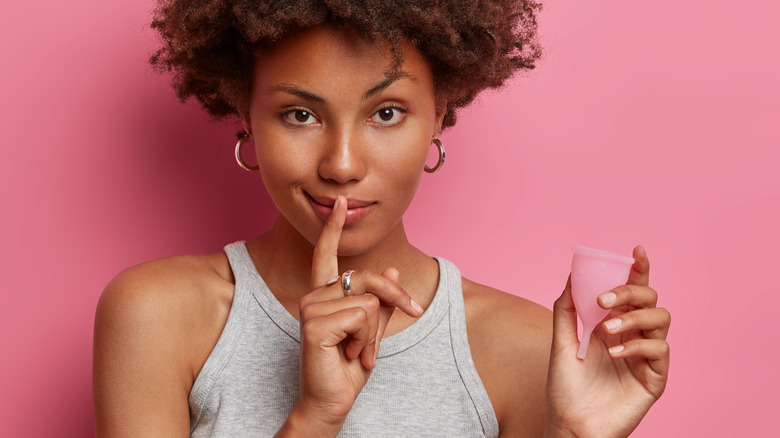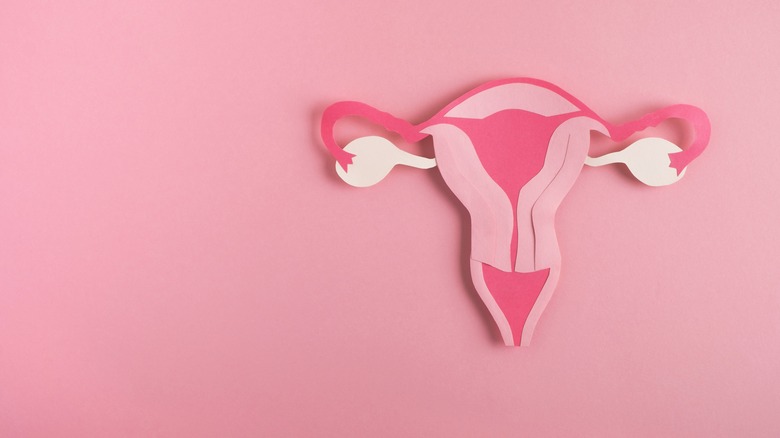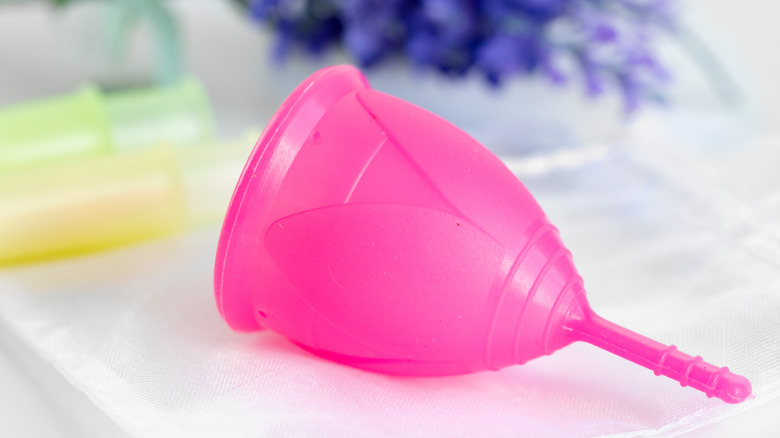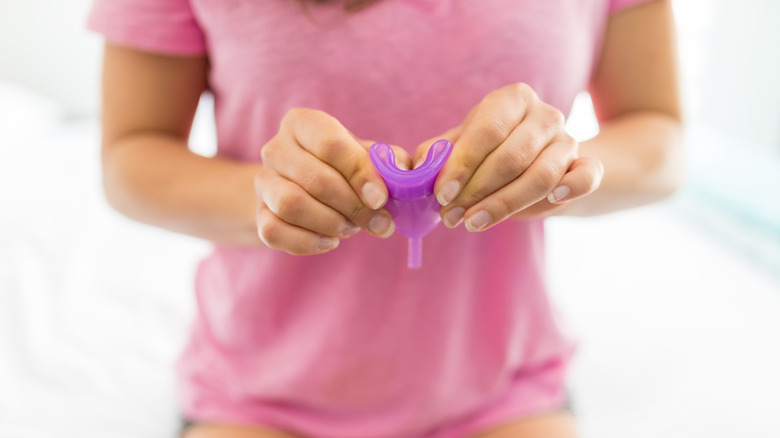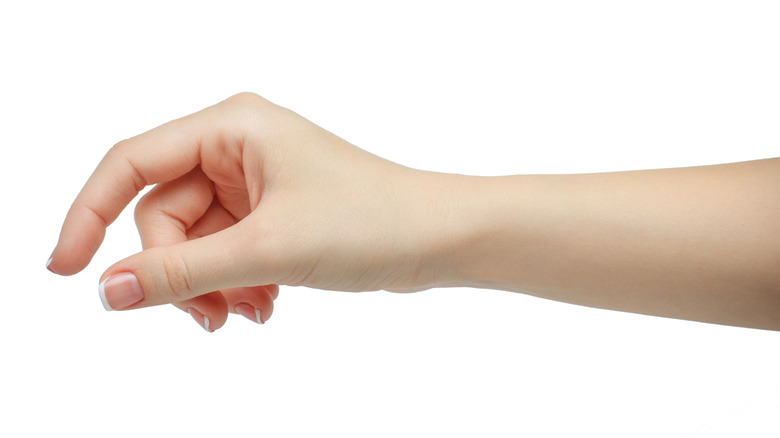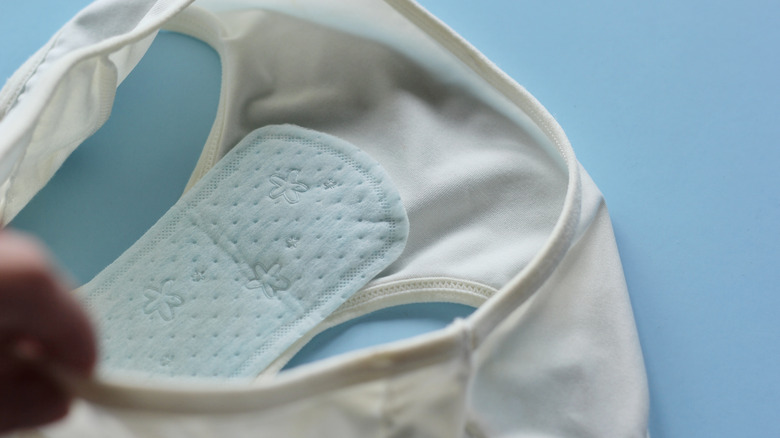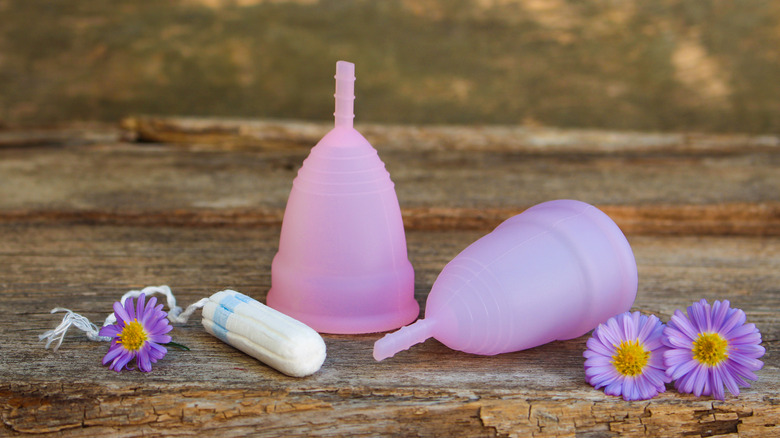Menstrual Cup Hacks That Can Make Using Them Easier
For many years, pads and tampons were pretty much the only options available for women when they had their period. Pads are great when it comes to allowing blood to flow out and not having to worry about the risk of toxic shock syndrome (TTS). Tampons offer the ability to do things like swim, wear just about anything you want and, as a bonus, when they are inserted the right way, you barely even feel them. However, when you think about all of the waste that both of these items produce and that you can't wear either one of them and enjoy sex, it's nice to know that there is another alternative — menstrual cups (via Healthline).
According to WebMD, the small cup — made of either silicone or rubber latex — is inserted into your vagina in order to collect your menses. Based on your flow, you can wear them for up to 12 hours, they don't throw off your pH balance, you can wear certain kinds during sex (for instance, a menstrual disc — via POPSUGAR), they come in a variety of sizes (via Healthline), and you can buy one for $20-40 and not need to replace it for up to 10 years (per POPSUGAR).
But using a menstrual cup comes with quite the learning curve. So, if you're considering getting one or you bought one and need some assistance with getting used to how they work, here are some hacks to hopefully make everything so much easier for you.
Make sure to do your research
The first thing that you should do is devote at least a couple of days to doing some online research. That's because, these days, there are all kinds of menstrual cups to choose from — different brands, different sizes, and even different ways that the bottom of the cups are designed so that you're able to take them out, dump your menses, and reinsert the cup into your vagina.
Thankfully, looking for which kind of cup is best for you isn't as challenging as it used to be. There are plenty of articles on the internet and videos on YouTube that offer pros and cons, prices, and almost anything else that you would like to know. For instance, Women's Health has 10 of the best cups that you can currently get on Amazon. Even The New York Times published a piece on what they consider to be the best menstrual cups.
As you're collecting data on all of this, just prepare yourself for probably having to purchase at least 2-3 cups and then trying out each one before finding your perfect fit. Also, be prepared to wear a light pad with your cup until you've mastered how to avoid leakage.
Conduct a vaginal self-exam to see if you have a high or low cervix
You probably know what your cervix is (it's a cylinder-shaped tube that connects your vagina and uterus to each other — via WebMD). Still, you will probably never give it as much thought as you will when you're shopping for the perfect menstrual cup. That's because, in order to avoid leaking, it's important to know whether your uterus is high or low.
According to Very Well Family, one way to do this is to wash your hands and then lie down on your back with your knees bent. Then gently and easily insert your index and middle finger into your vagina, all the way until you feel something that is reminiscent of a firm and round-shaped dimple; that would be your cervix. If it took your entire index finger to reach it, you have a high cervix. More specifically, according to POPSUGAR, "You have a high cervix if the length is 55 millimeters (2.25 inches) or higher. Your cervix is average height if the length is between 45 millimeters (1.8 inches) and 55 millimeters (2.25 inches). If the distance is 44 millimeters (1.6 inches) or lower, you have a low cervix."
All of this is important to know because different menstrual cups are made to accommodate different types of cervixes. It should also go on record that because cervixes tend to shift during menstrual cycles (via Healthline), this is another reason why you may want to get a couple of different ones.
Read the instructions and watch a few instructional videos too
Even if you're able to grasp the general concept of how to use a menstrual cup, it can be so helpful to check out all of the instructions that are directly associated with the type of cup that you decide to purchase. For instance, if you decide to go with a Saalt (which is a very popular brand), not only will a booklet come with the cup, their site has a quiz that you can take along with a Q&A section that can address other concerns that you may have.
Or, if you're someone who prefers to learn by watching videos, Put A Cup In It and Period Nirvana are two pretty popular channels that offer a wealth of knowledge and hacks for how to make menstrual cups feel more comfortable and leakage-proof. Also, board certified gynecologist Dr. Elena Rodriguez has her own YouTube channel. One of her videos explains why she's a fan of the DivaCup (another popular menstrual cup brand).
Definitely, menstrual cups can be intimidating at first, but the more knowledge you have, the more confident you will become about purchasing one and using it.
If you need suction, get a cup that comes with it
As stated earlier, not all menstrual cups are just alike. For instance, there are some that contain suction (air) holes and some that don't. If you want to have a bit more self-assurance that your cup will remain in place, a cup that comes suction can be a good idea because those will cling to your vaginal walls and hold the cup steady.
You may be wondering how you can comfortably take your menstrual cup out if there's suction going on? Mashable shares that this is where the bottom (some have a stem, some have a hook, etc.) of your cup comes in. First, pinch the base of your cup to release the suction. Then gently twist it and use the bottom of your cup to pull it out.
Now prepare yourself because you probably won't master this on the first try which means you could pinch yourself a bit while taking out your cup the first several tries. But you won't damage your cervix in the process, so long as you are not constantly misusing your cup (otherwise, there is a chance that you could experience pelvic organ prolapse over time — via BBC).
Test out different ways to fold the cup
Although women birth babies through their vagina all of the time (and a cup is so much smaller than that), that doesn't mean that you want to experience any discomfort while trying to put your menstrual cup in. That's why it's also a good idea to learn as much information about the kinds of "folds" that you can try in order to find which one works best for you.
POPSUGAR has on its site one of the most popular folds, which is oftentimes referred to as the "C-fold." You literally fold your cup over into a C and then use your thumb and index finger to keep the cup in that C position, so that you can insert it into your vagina, a couple of inches from your cervix.
If once you try that fold, it doesn't seem to work for you, again, there are other options. Put A Cup In It has a YouTube instructional video that features nine different folds while Period Nirvana offers up some great folding hacks and tips too.
'Squat and Pinch'
When it comes to putting a menstrual cup in, you definitely want to do this in the bathroom, preferably while you're in the shower or you're sitting on the toilet. The reason why is because there's no way around the fact that, because you're dealing with blood, menstrual cups have the potential to be messy; however, it's your blood and the more you get used to using one, the less mess you'll end up dealing with.
To put one in, Healthline recommends first wetting your cup or putting some lube on it (in order to make it "slide in" easier). Then fold your cup, pinch it and insert it like a tampon. Sherry Ross, M.D., women's health expert and author, takes a slightly different approach. She told SELF, "After washing your hands, you can insert a period cup while sitting, standing, or squatting. To do that, you fold the cup in half and, with your legs spread, guide it rim-first into your vagina. Once the stem is about half an inch from the opening of your vagina, rotate the cup so it can open all the way up and lock into place."
Squatting can help because it will open up your vagina more, so that it doesn't feel so much like you're trying to force your menstrual cup to go inside of you. It's a simple step that can make a significant difference.
Use pads and/or period panties at night
Healthline states that the average woman loses about 3-4 tablespoons of blood during each menstrual cycle. If you happen to lose more than that, that's not necessarily cause for alarm; however, because there is such a thing as menorrhagia (extremely heavy menstrual bleeding — via Mayo Clinic), it can never hurt to make an appointment with your physician, just to make sure that things are "flowing" as they should be.
That said, if you're curious about how much blood a menstrual cup is able to hold, WebMD says that it's roughly around one ounce of fluid which is about twice the amount of a super absorbent tampon. So, if you have an average flow, you should actually be able to keep a menstrual cup in for 12 hours which means that you can use it all throughout the night. Still, if you want some extra assurance that you won't leak, pads or period panties should be worn as well.
Just make sure that you also do some thorough research where period panties come into play. There has been some revealed research that the popular brand Thinx actually has a few toxic chemicals in them (via Fast Company).
Remember, that it's always wise to own more than one menstrual cup
Whether you've been using pads or tampons for years, you probably don't have just one size that you use the entire time. That's because your flow can be different throughout your cycle (via Healthline). The same thing can apply to menstrual cups because while silicone and latex rubber are designed to provide a comfortable fit, you may need a larger cup for heavier days and then want to go with a smaller size on lighter ones.
For instance, June is another popular menstrual cup brand that gives you the ability to purchase one cup or a "package deal" of a large and small one. That way, you can have two available to suit your specific needs which can always be a good thing.
Once you've mastered these hacks, you might discover that menstrual cups are one of the best things to ever happen to your period. Do lots of research. Have a few different ones in your stash. Be patient with the learning process. Do all of this and it's a period alternative that can be beneficial, in so many ways, for years to come.
